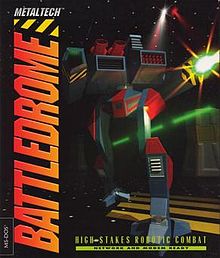Metaltech: Battledrome
Metaltech: Battledrome is a mecha-style simulation video game in the Metaltech series developed by Dynamix and released in 1994. It was published alongside its sister game Earthsiege and shares roughly the same gaming mechanics and strategy although in a completely different setting.
| Metaltech: Battledrome | |
|---|---|
 | |
| Developer(s) | Dynamix |
| Publisher(s) | Sierra On-Line |
| Producer(s) | Mark Crowe |
| Designer(s) | David Selle Tim Gift |
| Programmer(s) | Tim Gift |
| Artist(s) | Mark Crowe |
| Writer(s) | Neal Hallford David Selle Gregory Rucka Kurt Weber |
| Composer(s) | Christopher Stevens Timothy Steven Clarke |
| Platform(s) | DOS |
| Release | 1994 |
| Genre(s) | Simulation |
| Mode(s) | Single-player, multiplayer |
Graphics
The game features fully a three-dimensional simulation of robotic battle. All in-game objects are textured and there are rudimentary physics present. This was also one of the criticism points due to exceptionally high hardware requirements for typical computers at the moment of release.
Gameplay
The player competes against other players (over network) or against AI-players for local game. He must purchase the Herc chassis, generators, shields, servos as well as weapons and then challenge others to fight against him. During negotiation both parties can set stakes, in addition to independently calculated monetary prize for the winner, set fighting conditions, limit weaponry and then proceed to the battle.
The battle is carried out on the arena, limited in size by its borders. On the arena, two players compete tactically against each other and are overwatched by the flying referee bot, who assigns penalties (walking past arena borders) or can disqualify (in event, player uses forbidden weapon). The arena may contain a variable amount and type of obstacles, gun turrets, lightning conditions and has variable size.
Unique to the Battledrome is the model of energy distribution in the Herc. Each player can redistribute priority between engine, shield and weapons. Combined with weapon limitations, conditions met previously during negotiation phase between the players, Herc chassis qualities (some Hercs have stronger torso, yet weaker legs and vice versa) and arena hazards - this allows a variety of tactics: hit-and-run, outrun and cautious attack, direct assault, damage absorption with retaliation, outsmarting by weapon range and many others.
The fight ends based on condition defined during negotiation, typically with obliteration or surrender (which is time-delayed) of one of the players. The winner receives the prize as well as the enemy's bet. Additional rewards include higher ranking and reputation which unlocks access to heavier Hercs. The loser must pay his stake and goes down the ranking ladder. Both parties have option to repair their Hercs, although the losing party may have a drastically higher total repair costs due to the amount of damage taken.
If the player is able to maintain his Herc operational, he can challenge other players again. Otherwise, its a game over.
Reception
| Reception | ||||||
|---|---|---|---|---|---|---|
| ||||||
Computer Gaming World rated the game as less visually attractive than "its stablemate" Earthsiege and criticized the awkward controls and weak single player mode but praised the game's multiplayer feature.[1]
References
- James, Jeff (February 1995). "Battling For Bucks In Dynamix' Multiplayer METALTECH: BATTLEDROME". Computer Gaming World. Golden Empire Publications. p. 112,115–116. Retrieved July 4, 2017.
External links
- Metaltech: Battledrome at MobyGames
- Metaltech: Battledrome can be played for free in the browser at the Internet Archive